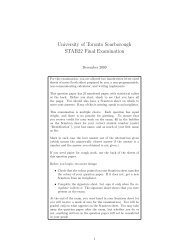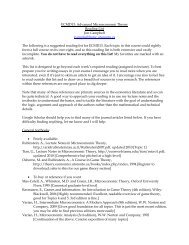Biological Sciences - University of Toronto Scarborough
Biological Sciences - University of Toronto Scarborough
Biological Sciences - University of Toronto Scarborough
You also want an ePaper? Increase the reach of your titles
YUMPU automatically turns print PDFs into web optimized ePapers that Google loves.
At a GlanceResearch Strengths Include<strong>Biological</strong> Dynamics <strong>of</strong> Environmental ChangeCells and InfectionIntegrative Behaviour and NeuroscienceNeurobiology <strong>of</strong> StressPlant Cellular and Molecular ProcessesPhysiologyAt a Glancefaculty & StudentsPr<strong>of</strong>essor Greg Vanlerberghe, Chair4 Canada Research Chairs19 faculty members1,837 undergraduate students64 graduate students (supervised)14 post-doctoral fellowsDimensions <strong>of</strong> LearningThe <strong>Biological</strong> <strong>Sciences</strong> department <strong>of</strong>fers undergraduatespecialist programs in Cell and Molecular Biology, Biodiversity,Ecology and Evolution, Human Biology and IntegrativeBiology, as well as a major and a minor in Biology. In addition,we’ve developed an undergraduate program in Neuroscience inpartnership with the Psychology department. We also <strong>of</strong>fer twojoint programs with Centennial College: career-bound studentsin Paramedicine and Applied Microbiology graduate after fouryears with both college diplomas and university degrees.We add an experiential dimension to undergraduate studiesthrough a variety <strong>of</strong> avenues. A co-op program in Cell andMolecular Biology enables talented students to explore futurecareer possibilities through placements with pharmaceuticalfirms, research laboratories and government agencies. In 2009 theNatural <strong>Sciences</strong> and Engineering Research Council <strong>of</strong> Canada(NSERC) again funded summer jobs for several students, whilemany more were hired directly as assistants by faculty researchers.Undergraduates can also gain experience via work-study programsduring the academic year, and through initiatives such as ScienceEngagement, which invites top UTSC students to share theirpassion for learning in high school classrooms around thecommunity. In addition, the department typically provides afourth-year research project course for about 50 students annually.At the graduate level, our faculty provide on-site supervisionfor more than 50 MSc and PhD students enrolled in tri-campusgraduate programs. The <strong>Biological</strong> <strong>Sciences</strong> department excelsin graduate and postdoctoral training, <strong>of</strong>fering high-qualityfacilities, well-funded research programs and the <strong>University</strong> <strong>of</strong><strong>Toronto</strong>’s acclaimed network <strong>of</strong> resources and expertise.> FACULTY pr<strong>of</strong>ileIndependentThinkersWhen lecturer Aarthi Ashok joined the <strong>Biological</strong><strong>Sciences</strong> department in 2009, she set to workcreating a course on the pathobiology <strong>of</strong> humandisease. An introduction to current research onviral infections, the course also reflects recentevents. “Students in the GTA have seen thetorment <strong>of</strong> pathogens such as SARS and H1N1,”says Ashok (pictured below with UTSC students),“so it’s important for them to understand themolecular details <strong>of</strong> these infections while alsoappreciating their impact on global public health.I believe it’s critical for biologists to stay abreast <strong>of</strong>research on emerging human pathogens, so thiscourse will be designed to evolve with the field.”Another key aspect <strong>of</strong> Ashok’s mandate is tomake fourth-year students’ independent researchprogram a more well-rounded experience. In additionto their lab work, students will now spend timedeveloping written and oral presentation skills;they’ll also discuss issues such as research ethics.“The goal is to supplement undergraduates’research experience with the skills that arerequired <strong>of</strong> budding scientists,” Ashok explains.“And as they address important research questions,it also expands my own scientific horizons.”degree <strong>of</strong> InterestPlanning is well under way for a new undergraduateprogram leading to a Biodiversity,Ecology and Evolution Specialist degree – withthe apt acronym BEES. Slated for the fall <strong>of</strong> 2010,the program develops students’ understanding <strong>of</strong>how ecology and evolution shape the morphology,physiology and behaviour <strong>of</strong> individual organisms,as well as the nature <strong>of</strong> entire ecosystems.Challenges such as habitat destruction, biologicalinvasions and climate change will be examinedwithin a global framework. Among those launchingthe program is new faculty member Pr<strong>of</strong>essorMarc Cadotte, an ecologist who studies extinction,invasions and other factors driving diversitychanges in plant communities.The new BEES degree will prepare graduatesfor roles in government, NGOs and consultingfirms, as well as business or law with an environmentalfocus. The program can also lead to graduatestudies – including a Pr<strong>of</strong>essional Master’sdegree in Conservation and Biodiversity thatour department has proposed to complement theMaster <strong>of</strong> Environmental Science degree.Recognizing StudentsThe many dedicated students in <strong>Biological</strong> <strong>Sciences</strong>are ably represented by Edward Eng (picturedbelow), winner <strong>of</strong> the 2009 PhD Graduate StudentResearch Award for his academic achievementsand contributions to campus life. Having earnedBSc and MSc degrees at UTSC, he is completing hisdoctoral research on macrophages – white bloodcells that are crucial to the body’s defense againstinfection. Outside the lab, Eng founded a chapter<strong>of</strong> the national Let’s Talk Science program,volunteering to promote science in local schoolsand encouraging fellow students to follow suit.Recognized by his pr<strong>of</strong>essors as a natural teacher,Eng has treasured his 10 years at UTSC: “I feel likeI’m part <strong>of</strong> a community here, which is why I’ve puta lot <strong>of</strong> time and energy into different activities.”> Research ShowcaseStress on the BrainThe aging <strong>of</strong> Canada’s population over the next decade will bringa steady rise in the incidence <strong>of</strong> heart attacks and strokes, alongwith Alzheimer’s, Parkinson’s and other neurodegenerativediseases. Critical research on the brain’s role in these conditionsgot an important boost this past year when the Centre for theNeurobiology <strong>of</strong> Stress (CNS) secured additional infrastructuresupport from the Canada Foundation for Innovation. With amatching grant from the Ontario Research Fund, the new fundingtotals more than $4 million.The CNS was founded in 2001 by Pr<strong>of</strong>essor Ian Brown, amolecular biologist who holds a Canada Research Chair in theneurobiology <strong>of</strong> stress. The centre is home to a cluster <strong>of</strong> UTSCresearchers who bridge the molecular, cellular and physiologicalaspects <strong>of</strong> neuroscience. Virtually all <strong>of</strong> the new funding will go totechnology that aids in examining the nervous system’s responseto biological stress. The researchers also explore new therapeuticapproaches – <strong>of</strong>ten in partnership with Canadian companies – fortreating cerebrovascular and neurodegenerative disorders.Among the beneficiaries is Pr<strong>of</strong>essor Michelle Aarts (shownbelow with Pr<strong>of</strong>essor Ian Brown), a cell and systems biologistand Canada Research Chair whose team studies the impact <strong>of</strong>strokes at the level <strong>of</strong> single neurons. “Our research targets themechanisms <strong>of</strong> neuronal death following a stroke injury,” explainsAarts. “The underlying causes <strong>of</strong> cell death and the progression<strong>of</strong> the brain lesion are still poorly understood. We hope to gaininsights into which signal pathways influence cell survival.”While Aarts and her colleagues work in a highly technical fieldwith a language all its own, the reality <strong>of</strong> the afflictions they studyis never far away. “Stroke is a devastating disease with a severeimpact on quality <strong>of</strong> life for patients and their families. It’s also thethird leading cause <strong>of</strong> morbidity and mortality in Canada and coststhe healthcare system almost $3 billion annually,” she notes. “Ouraim is to understand how cells communicate, recover from injuryor die, so we can develop the first effective treatments toprotect the brain from damage and speed functional recovery.”24university <strong>of</strong> toronto scarboroughannual reviewuniversity <strong>of</strong> toronto scarboroughannual review25


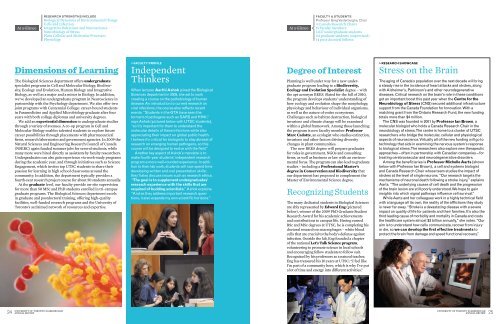
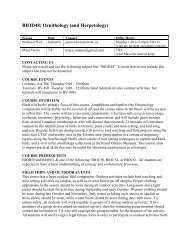
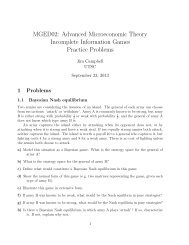
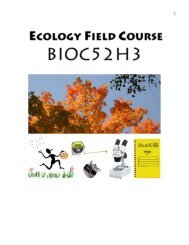

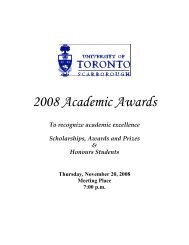
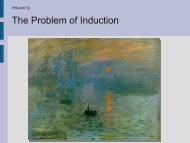
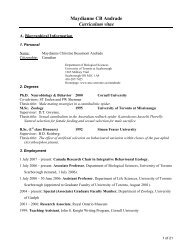
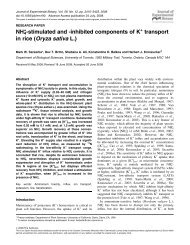
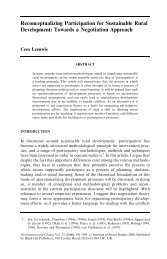
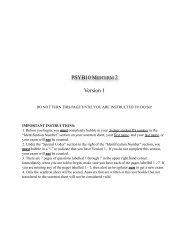
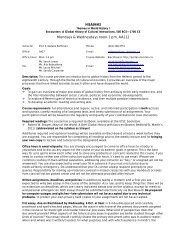
![[Enter course name - Syllabus] - University of Toronto Scarborough](https://img.yumpu.com/50068522/1/190x245/enter-course-name-syllabus-university-of-toronto-scarborough.jpg?quality=85)
